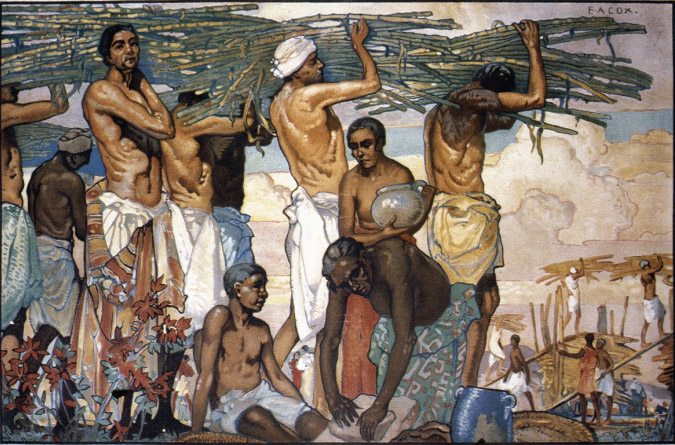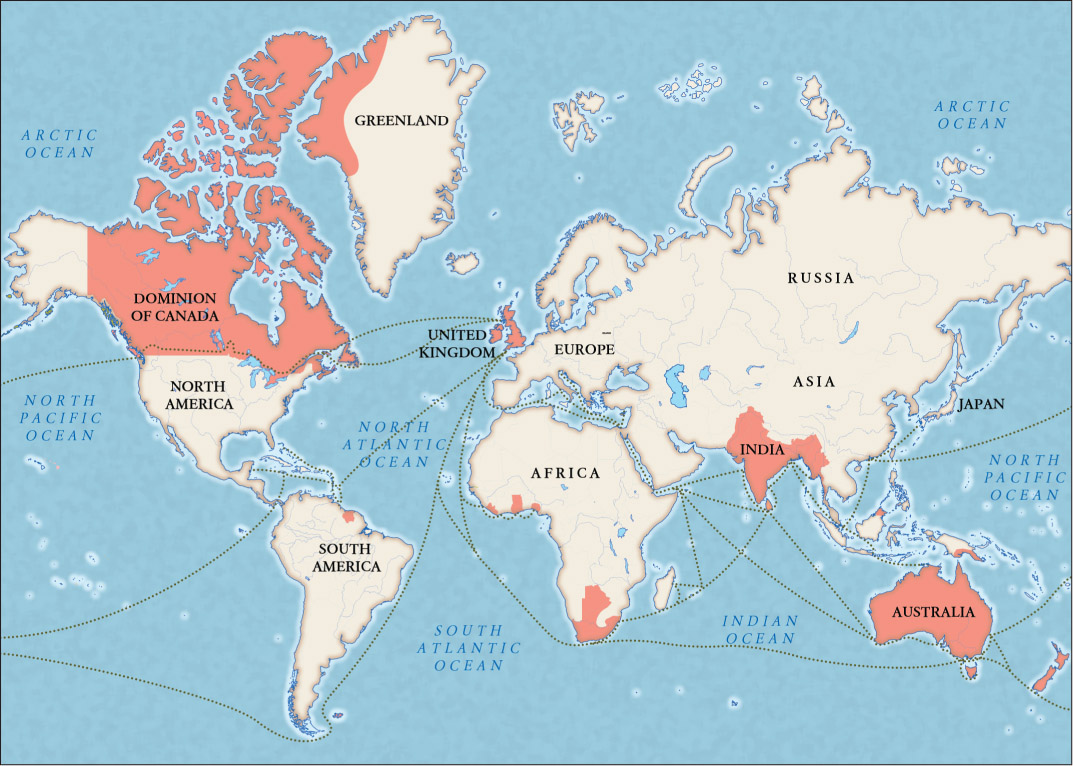10.4 European imperial expansion
Globalisation is currently a hot topic, yet it has been occurring for centuries, not least because of European imperial expansion from the sixteenth century onwards. Spain, Portugal, the Netherlands, Britain and France all acquired large empires in the early modern period of world history, as they sought spices in the East Indies, navigated and charted their way around parts of the globe unknown to Europeans, established trading posts and then expanded and defended the territories they acquired. The goal of Christian missionaries, both Catholic and Protestant, to convert indigenous peoples around the world was allied to the desires of traders and the ambitions of armies. These European powers grabbed colonies in the Americas, South and Southeast Asia, Australia, the Pacific, East Asia and Africa.
European colonies in the Americas, including the Caribbean, soon had economies based on sugar, cotton, tobacco and coffee plantations.
Industrialisation and imperialism were interconnected. Profits made in the colonies were invested in Europe in stately houses and grand buildings, and in finance, business and industry.

Commodities from the colonies were shipped to Europe for food and manufacturing. For example, cotton grown in the Americas was turned into clothing and ‘manchester’ (household textiles) in the British industrial Midlands which Britain then exported (including to its colonies) while sugar from the Caribbean and Mauritius was consumed in Europe, along with tea from India, Ceylon and Malaya. Australian wool, wheat, meat and fruit, timber from Burma, cocoa from the Gold Coast in Africa, New Zealand butter and apples, South African fruit and wine, tobacco grown in Africa, and Canadian timber and furs all found markets in Britain and elsewhere. Profits from trade sustained European imperial armies and colonial administrations in Asia and Africa.
European industrialisation also provided their armies with superior military technology, including steamships and machine guns, which were critical to imperial conquests and control.
Source 10.8a European imperial expansion (06:53)

European imperialism in Asia
In 1800, Europeans occupied or controlled one-third of the globe’s land surface. By 1870 this had leapt to two-thirds and by 1913 had become an overwhelming 84%, including much of Africa, South America, Asia and the Pacific. Some parts of Asia came under formal imperial control and direct administration of European powers, while others such as China mostly remained independent but ceded small zones and were buffeted by European and American expansionist desires. From the seventeenth century, Britain increasingly established its hold on the Indian sub-continent. By 1763, the British East India Company controlled significant parts of India, and had defeated their French rivals; British control in India grew through the nineteenth century. The French turned their attention to Indochina.
The European imperial powers sought trade, profits and territorial control; they also introduced Christianity, turning it into a worldwide religion.
Missionary societies based in Europe and America funded the work of missionaries across Asia, Africa and the Pacific. Missionaries sought to convert colonised peoples, and did much to destroy indigenous cultures, but they also provided practical help in the form of medicine, agriculture and education. Mission schools and hospitals spread across European colonies, and missionaries taught cricket, football, athletics and Western music, along with other subjects.
European colonies suffered from economic exploitation designed to benefit the imperial powers. For example, Britain suppressed cotton textile production in India in order to protect sales of cloth made in the British Midlands. In Java, Dutch colonial rulers forced farmers to sell certain parts of their crop to the colonial government at a low price; the Dutch made huge profits from this system. Colonial regimes also relied on racial hierarchies and discrimination in education, employment, official languages and public spaces, and used violence and harsh punishments to stay in power.
By the late nineteenth century, anti-colonial nationalist movements emerged, especially among the educated and professional elite of the indigenous people. Elite Indians, for example, attended British universities before returning to India as lawyers, doctors, journalists and other professionals. Anti-colonial movements gained support in the twentieth century, both domestically and globally, and were a major reason for the dismantling of the European empires in the mid-twentieth century, often through bloody warfare. Gandhi’s nationalist movement in early twentieth century India helped to spread the ideas and practice of non-violent resistance around the world, while some of the religious and philosophical values of, for example, Buddhism and theosophy entered Western culture.
Colonies and independent states in Asia
By the late nineteenth century, Britain exerted control over all India, though in some princely states that control was indirect. In 1857–58 the British Raj suppressed a major uprising that began in the army, and India remained under British control until 1947, when on 15 August India and Pakistan (the latter divided into western and eastern sections) became independent nations. In Indonesia, the Netherlands established trading posts in the early seventeenth century, which expanded by the nineteenth century into full colonial control of Java and parts of Sumatra, Borneo and Timor – an effective dominance of the Indonesian archipelago. During World War II, the Dutch were ousted by the invading Japanese, and then temporarily regained control before being forced to cede Indonesian independence in 1949.
In Indochina, the French gradually expanded their influence and control over Vietnam, Cambodia and Laos until they became French colonies in the late nineteenth century. Early twentieth century anti-colonial nationalist movements were violently suppressed by the French. After World War II, the war for independence in Vietnam was initially against the French, before it became a civil war between North and South in which the United States, Australia and other countries became involved.
Spanish traders and missionaries arrived in the Philippines in the sixteenth century and their interest in the islands spread until they were under Spanish control by 1570. In 1898, the United States purchased the Philippines from Spain, as it expanded its imperial control in the Caribbean and the Pacific, which would include Hawai’i. The Philippines gained its independence from the United States after World War II, though some military bases remained. China, long an imperial power in East Asia, did not fall under formal control of the European empires, though in 1842 Britain took Hong Kong as its victory prize from the Opium War. As China weakened internally in the nineteenth century, European and American demands for trade and influence resulted in open treaty ports such as Canton and Shanghai. Europeans and Americans established their own zones of residence and business in Chinese ports, and Christian missionaries arrived, but China maintained its sovereignty. Japan also remained independent, but in 1853 was forced by the United States to open itself to contact and trade, which had profound effects on its internal politics and economy.
